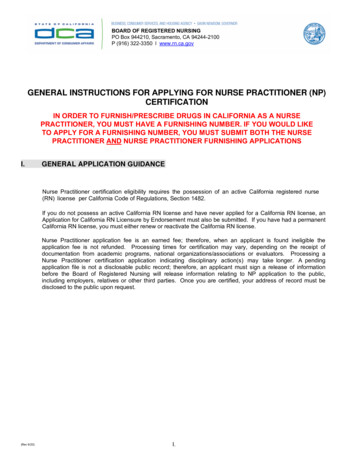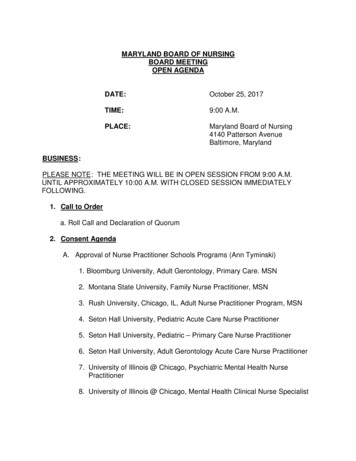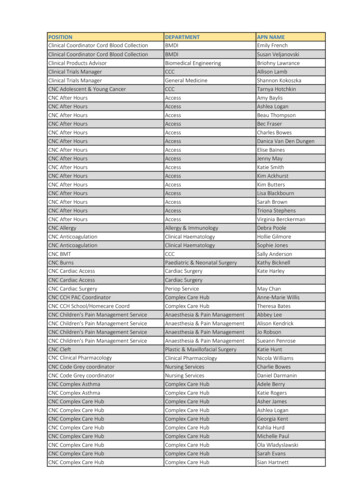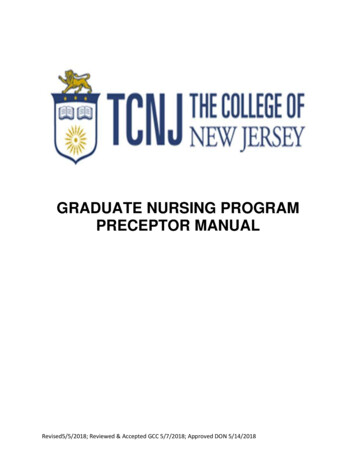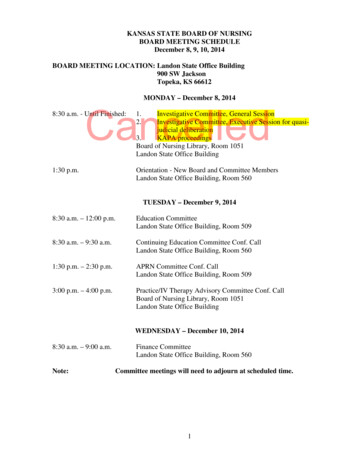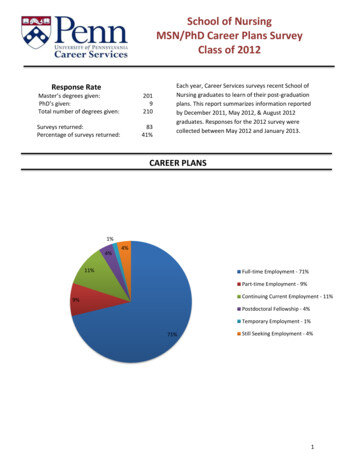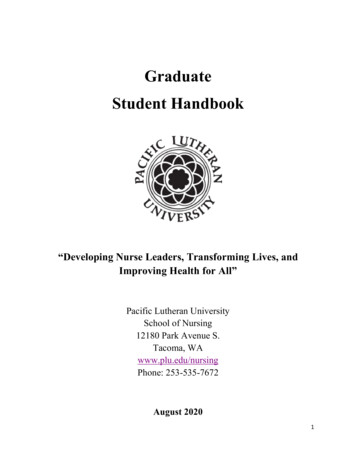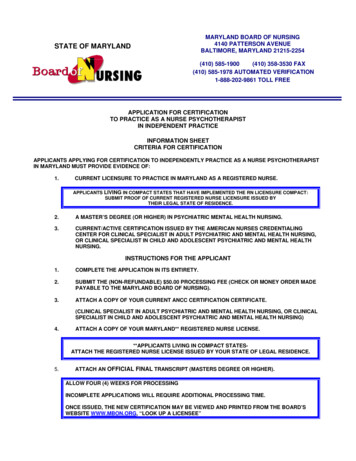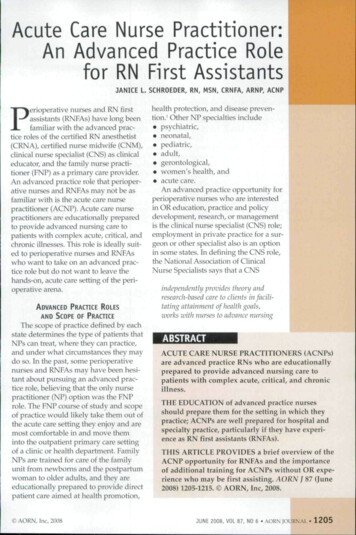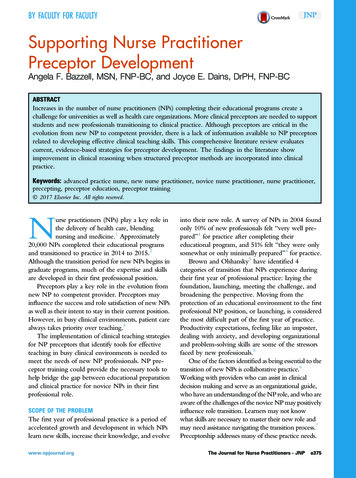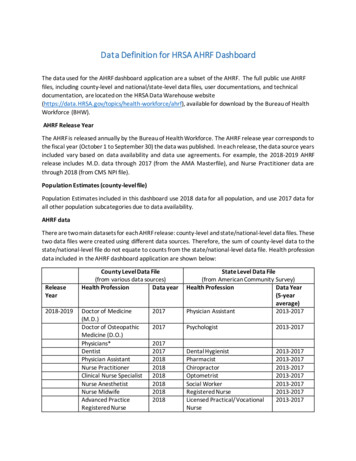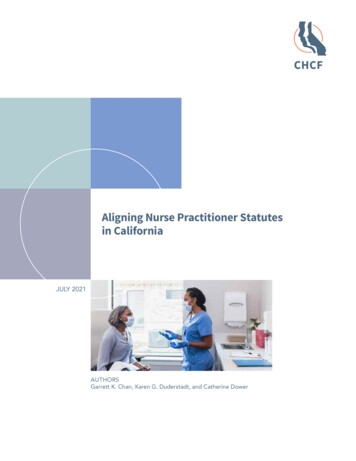
Transcription
Aligning Nurse Practitioner Statutesin CaliforniaJULY 2021AUTHORSGarrett K. Chan, Karen G. Duderstadt, and Catherine Dower
ContentsAbout the AuthorsGarrett K. Chan, PhD, RN, NP, is president andCEO of HealthImpact. Karen G. Duderstadt,PhD, RN, is clinical professor emerita in theDepartment of Family Health Care Nursing,School of Nursing at UCSF. Catherine Dower,JD, is a health policy consultant.AcknowledgmentThe authors would like to thank Dr. Susanne J.Phillips, DNP, RN, FNP-BC, FAANP, FAAN, forher significant contribution to this publication.About the FoundationThe California Health Care Foundation isdedicated to advancing meaningful, measurable improvements in the way the health caredelivery system provides care to the people ofCalifornia, particularly those with low incomesand those whose needs are not well servedby the status quo. We work to ensure thatpeople have access to the care they need,when they need it, at a price they can afford.CHCF informs policymakers and industryleaders, invests in ideas and innovations,and connects with changemakers to createa more responsive, patient-centered healthcare system.DESIGN BY DANA KAY HERRICK3 Executive SummaryIntroduction and BackgroundMethodology4 Findings and DiscussionList of Statutes for Review and ActionAccess to CareOpioid CrisisCare of Vulnerable Adults6 Conclusion7 AppendicesA. Aligning Existing California Statutes and Regulationswith AB 890B. 103 and 104 Nurse PractitionersC. States with Global Signature Laws16 Endnotes
Executive SummaryCalifornia legislation (Assembly Bill 890, orAB 890) enacted in September 2020 authorizescertain nurse practitioners to practice withoutphysician supervision and standardized procedures.1Implementation of this statute holds significant promise to expand access to high-quality care, particularlyfor underserved places and populations. The Board ofRegistered Nursing (BRN) is tasked with appointinga Nurse Practitioner Advisory Committee, reviewingcurrent nursing regulations, and promulgating regulations and guidelines to implement AB 890.2 To meetthe access to care needs in California, it is essentialthat the BRN complete this work with expediencysince nurse practitioners cannot practice without physician supervision before the BRN work is completed.To realize the intent of AB 890 and provide maximumbenefit to Californians, action is also required to alignexisting, related statutes, including provisions ofCalifornia’s Education, Health and Safety, and LaborCodes. This report offers an analysis of existing statutes that, without review and action, may inhibit fullrealization of the promise of AB 890.Introduction and BackgroundIn 2020, California enacted legislation (AssemblyBill 890) to expand the practice authority for nursepractitioners (NPs). This legislation holds promise toincrease access to primary care and other services byallowing NPs to offer care within a defined scope ofpractice without physician supervision requirements.With this statute, California joins 28 other states thatpreviously expanded NPs’ scope of practice.The law promotes NPs as important providers of healthcare for underserved and vulnerable populations, particularly in rural areas with limited access to primarycare services. AB 890 creates two new categories ofnurse practitioners allowed to practice without physician supervision, as detailed in Appendix A. For ease ofnomenclature, these two categories are often referredto as “103 NPs” and “104 NPs” to correspond tothe respective statutory sections defining each underBusiness and Professions Code (BPC) §§ 2837.103 andAligning Nurse Practitioner Statutes in California2837.104. Currently, nurse practitioners are authorizedto practice via standardized procedures developed bythe NP, supervising physician, and health care organization pursuant to BPC § 2725(c), BPC § 2836.1, andTitle 16 of the California Code of Regulations (CCR) §§1470 –1474. Additionally, the standardized proceduremust define physician supervision requirements. (SeeCal. Code Regs. tit. 16, § 1474(b)(7)). Simultaneously,AB 890 defines eligibility requirements for NPs topractice without physician supervision, including certification from a nationally accredited certifying entityand completion of postgraduate transition-to-practice(TTP) requirements in California.3 AB 890 also requiresthe Board of Registered Nursing to appoint a NursePractitioner Advisory Committee, review current nursing regulations, and promulgate regulations andguidelines to implement AB 890.The passage of AB 890 represents an important stepto meet the pressing health care needs in the stateby expanding the independent practice of nursepractitioners. The legislation also elevates the needto reexamine intersecting statutes, regulations, payerpolicies, clinical agency operations, interprofessionalteam structures, health care finance, and employmentrelationships and align them to fully realize the goalsand intent of AB 890.This report examines existing statutes and regulationsthat could be updated to align with AB 890. The reportuses three priority policy issues — increasing access tocare, especially in underserved communities of color;managing the opioid crisis; and caring for vulnerableolder adults — to illustrate how statutory and regulatory alignment could enhance the state’s capacity tomeet community health care needs. Solutions to thesepolicy issues are multifactorial. However, researchpoints to expanded NP practice as one meaningfulsolution. States that removed physician supervision ofNPs experienced a growth in the number of routinecheckups, increased access for rural and vulnerablepopulations, decreases in emergency departmentuse, and reductions in health care costs.4 Evidenceindicates that NP services ensure quality of care forchronic illnesses and improvement in functional statusfor patients in long-term care facilities.5 Also, access towww.chcf.org3
treatment for opioid use disorder increased in stateswhere there was no physician oversight of NPs compared with states that required NP supervision.6 Insurance Code (INS) Labor Code (LAB) Probate Code (PROB)Methodology Unemployment Insurance Code (UIC)Research for this report included a review of theCalifornia laws related to NP practice that could beupdated to be in greater alignment with AB 890. NPexperts in practice, administration, education, andpolicy were queried about statutes that codify NPpractice in California. Subsequently, the research teamconducted a search of California code sections via theCalifornia Legislative Information website (leginfo.legislature.ca.gov) and Westlaw or LexisNexis using thesearch terms “nurse practitioner,” “advanced practiceregistered nurse,” “scope of practice,” and “standardized procedures” to generate a list of statutes foranalysis. For each statute, the research team identifiedthe issue and the background of the statute, analyzedthe statute’s alignment with AB 890, and made recommendations regarding any misalignment with thepolicy enacted in AB 890 or its underlying goals. Welfare and Institutions Code (WIC)Findings and DiscussionList of Statutes for Review andActionThe research team reviewed a comprehensive, but notexhaustive, list of California statutes that govern healing arts practitioners and identified opportunities forbetter alignment between existing laws and new legislation or regulatory action. Specifically, the analysisincluded a review of how newly authorized practiceauthority for NPs under AB 890 may affect and interact with sections of the Business and Professions Code(BPC) as well as other California codes, including butnot limited to the following: Education Code (EDC) Evidence Code (EVID) Health and Safety Code (HSC)California Health Care FoundationAppendix A provides detail on these statutes andregulations.To illustrate how existing statutes and identified areasof misalignment play out in practice, three priorityhealth challenges confronting California are describedin the next sections: access to care, the opioid crisis,and care of vulnerable adults. Aligning existing statutesto reflect the policy enacted in AB 890 has the potential to advance progress on these important issues.Access to CareOne of the biggest challenges in California is ensuring access to high-quality care, particularly primarycare, in all parts of the state. Many communities— from rural areas to low-income urban neighborhoods — face barriers to accessing care. In part, thesebarriers are driven by an inadequate supply of providers to provide high-quality, culturally inclusive care.According to the California Future Health WorkforceCommission, in just 10 years, California is projectedto face a shortfall of more than 4,100 primary careclinicians.7 The commission also found that sevenmillion Californians — with the vast majority beingLatino, Black, and Native American — live in HealthProfessional Shortage Areas, a federal designation forcounties experiencing shortfalls of primary care, dental care, or mental health care providers. AB 890 is, atits core, a health care access intervention, and whilethe legislation largely supports this intent, a few statutory considerations would benefit from considerationin order to advance the expansion of access to care.In addition, although nurses may legally form nursingcorporations in California pursuant to CorporationsCode § 13401.5(f), NPs have historically facedwww.chcf.org4
administrative and bureaucratic barriers to makingthese corporations financially and practically viable.Updates are needed to statutes, rules, and regulationsassociated with laws that define owning or operating abusiness or employing healing arts licensees in orderto ensure that nurses may form and run corporationsto provide a full range of clinical services with qualified personnel. For NPs, additional legal and practicebarriers to the types of groups and corporations withwhich managed care entities contract may require further analysis.Another hurdle to realizing the potential of NPs’practicing to the full extent of their education is thedisconnect between AB 890’s authorization of NPs’practicing without physician supervision and otherlaws, such as California’s laws regarding managedhealth care plans. Known as the Knox-Keene Act of1975, HSC § 1340 et seq. is a nearly 50-year-old set oflaws designed to ensure that managed health care isregulated appropriately and that physicians’ and otherhealth professionals’ decisions about patient care arenot unduly affected by managed care companies.For example, HSC § 1375.9 requires that there be atleast one full-time equivalent primary care physicianfor every 2,000 enrollees of a managed health careplan. NPs with their own primary care clinic practicesmay not satisfy this requirement. Permitting healthplans to consider NPs when demonstrating that theplans have met network adequacy standards would beconsistent with the policy enacted in AB 890. A comprehensive review of all nuances of the Knox-KeeneAct will need to be conducted to evaluate any potential discrepancies or inconsistencies between AB 890and Knox-Keene.Opioid CrisisCalifornia continues to experience an opioid abuse crisis and increases in opioid-related deaths. California’sopioid overdose death rate in 2019 was 7.9 deathsper 100,000, up 2.3 deaths per 100,000 since 2017.8A recent report on buprenorphine, a treatment foropioid addiction, indicated a nearly fourfold increasein buprenorphine prescriptions in the state between2014 and 2018.9 The supply of chemical dependencyAligning Nurse Practitioner Statutes in Californiaresources — from hospitals to the workforce — doesnot meet the demand from individuals ready to seektreatment for substance abuse disorders. The numberof chemical dependency beds decreased in Californiaby 26.2% between 2005 and 2014, while the rate ofaddiction to opioids was increasing.10In states or situations where physician supervisionof NPs is required, the supervising physician mustalso be qualified to prescribe buprenorphine. WhenAB 890 is implemented, NPs will have full authoritypursuant to BPC §§ 2837.103(c)(4) and 2837.104(a)(1)to prescribe buprenorphine and to treat individualsseeking help for opioid addiction, which will increaseaccess options, particularly for the homeless and othervulnerable populations in California affected by substance use disorders.Two regulations related to chemical dependencytreatment that were not addressed in AB 890 concern medical staff privileges in chemical dependencyhospitals and the care provider list for psychiatric andmental health services. Although AB 890 authorizes103 NPs to serve on medical staff and hospital committees and 104 NPs to be eligible for medical staffmembership, chemical dependency facilities were notspecifically considered in the legislation. To align withAB 890, the California Code of Regulations could beupdated to explicitly authorize NPs to serve on medical staff committees or be eligible for medical staffmembership of chemical dependency recovery hospitals (Cal. Code Regs. tit. 22, § 79303) and includepsychiatric mental health NPs on the list of Medi-Calproviders recognized for psychiatric and mental healthservices with county mental health plans (Cal. CodeRegs. tit. 9, § 1810.240). These two updates wouldreduce discrepancies between laws and regulations,facilitating the implementation of AB 890 and therebyincreasing the potential to expand chemical dependency services in California.Care of Vulnerable AdultsSkilled nursing facilities (SNFs) and long-term carefacilities have been particularly vulnerable duringthe COVID-19 pandemic. Long-term care facilitywww.chcf.org5
residents represented about 3.5% of the COVID-19cases in 2020 but represented 64.9% of deaths due toCOVID-19.11 SNFs and long-term care facilities oftencare for populations with complex chronic healthconditions, including hypertension, cardiac disease,diabetes, and cognitive impairment, which increasevulnerability to infections.the pandemic. A recent study focused on ADHCsin California and the impact of the closures founddeclines in physical, cognitive, and mental health usersof ADHCs and increased caregiver strain.12 Expandingmental health services in ADHCs has the potential toimprove treatment management among this vulnerable, underserved population in California.In 1973, the California Legislature passed the LongTerm Care, Health, Safety, and Security Act (HSC §1417 et seq.). This law was created to ensure the quality of care in long-term health facilities by delineatingminimum standards of care and by creating a licensing, inspection, and reporting system and a citationsystem for a wide variety of long-term care facilities.Some long-term care facilities, such as skilled nursing facilities, are regulated by both the state and theMedicare Conditions of Participation. Other long-termcare facilities, such as congregant living health facilities, are regulated by the state.Welfare and Institutions Code § 14550(e), which governs the services and standards provided in ADHCs,lists the health care professionals permitted to providepsychiatric or psychological services: a psychiatrist, aclinical psychologist, or a psychiatric social worker.Psychiatric/mental health NPs (PMHNPs) are educatedand qualified to provide psychiatric and psychological services to older adults who need individualassessments and/or group or individual treatment forpersons with diagnosed mental, emotional, or behavioral problems. Amending this section of the Welfareand Institutions Code to include NPs would provideclarity to the list of qualified psychiatric/mental healthproviders authorized to provide care in ADHCs andcould have a positive impact on access to mentalhealth services in ADHCs.Under AB 890, NPs could independently treatpatients in long-term care facilities. However, existinglanguage in the Health and Safety Code limits theircontributions. Specifically, the long-term care codesections related to patient admission and treatment(HSC § 1417 et seq.) could be updated to allow NPs topractice in these facilities, improving continuity of careand eliminating gaps in care. Such changes have thepotential to improve management of complex chronichealth care conditions in long-term care facilities andto decrease public health costs in California over time.Further, statutes governing respite care services inintermediate care and skilled nursing facilities (HSC§ 1418.1) could be updated to allow an NP who istreating a person being admitted to respite care theauthority to issue advance orders for care and treatment for that person, thus providing continuity of careand better oversight of the various aspects of care forthat patient while addressing gaps in care in vulnerable and underserved populations.Adult day health care centers (ADHCs) supportthe health and social needs of vulnerable olderadults. Many ADHCs were forced to close duringCalifornia Health Care FoundationConclusionIn a review of the California codes, many statuteswere found to be misaligned with the newly enactedAB 890. This misalignment may limit the opportunityand intent of the legislation. Concerted effort will berequired through a variety of interventions, including legislation, administrative action, and change inpractice and operations, to realize the full benefit ofthe scope of practice reform for nurse practitioners inimproving access to and quality of care.This report has focused predominantly on the inconsistencies in clinical care and practice operationsdescribed in the various California codes. Furtheranalyses of the intersection of AB 890 with healthplans, health care financing, and the business aspectsof a practice are needed.www.chcf.org6
Appendix A. Aligning Existing California Statutes and Regulations with AB 890The statutes cited in Table A1 are presented in twocategories. The first category contains statutes thatare inconsistent with the intent and policy of AB 890,including statutes that predate the passage of AB 890and reflect a pre-AB 890 physician supervision of NPpractice. In many cases, these laws do not expresslyexclude 103 NPs and 104 NPs; rather, the laws do notinclude these NPs, and therefore the inconsistent statutes could be seen as restricting the practice of 103NPs and 104 NPs even after the passage of AB 890.Also, many of the laws in the first category alreadyconfer authority to NPs who practice under standardized procedures. AB 890 authorizes 103 NPs and 104NPs to practice without physician supervision andwithout the use of standardized procedures.13 Each ofthese code sections could be clarified to include reference to 103 NPs and 104 NPs to ensure that they canpractice without standardized procedures, so that theintent of AB 890 is not diminished.Table A1. Category 1: Laws That Conflict with Policy Established in AB 890, continuedISSUEPRE-AB 890 CALIFORNIA STATUTEAB 890 CALIFORNIA STATUTEMedical assistantsupervisionBPC § 2069(a)(2)(A). This law authorizes NPsto delegate tasks to medical assistants pursuantto standardized procedures.103 NPs and 104 NPs may delegate tasks tomedical assistants under AB 890 pursuant to BPC§ 2837.103(c)(6) and BPC § 2837.104(a)(1). Pre-AB890 statute could be updated accordingly.Dispensing drugs tooutpatients in hospitalsthat do not employfull-time pharmacistsBPC § 4056(f). This law authorizes physiciansto dispense drugs to outpatient patients in ruralhospitals and licensed hospitals that contain100 beds or fewer and that do not employ afull-time pharmacist.BPC § 2837.103(c)(4)(B) authorizes 103 NPs and104 NPs to dispense drugs. Pre-AB 890 statutecould be updated accordingly.Furnishing nonprescrip- BPC § 4057(b)(1). This law specifies the healingtion drugs and devices arts professionals to whom a person can sellto NPsor furnish specific nonprescription drugs anddevices. NPs are not listed as being able to buynonprescription drugs and devices.103 NPs and 104 NPs are able to procure,dispense, and furnish over-the-counter, nonprescription drugs and devices pursuant to BPC§ 2837.103(c)(4)(B). Pre-AB 890 statute could beupdated accordingly.Furnishing prescriptiondrugs and devicesBPC § 4059(a). This law specifies the healingarts professionals to whom a person can sell orfurnish prescription drugs and devices. NPs arenot listed as being able to buy nonprescriptiondrugs and devices.103 NPs and 104 NPs are able to procure andprescribe over-the-counter, legend, and controlledsubstances pursuant to BPC § 2837.103(c)(4)(B).Pre-AB 890 statute could be updated accordingly.Possessing andstocking of drugsand devicesBPC § 4060. This statute limits the possessionof any controlled substance to NPs functioningpursuant to standardized procedures. Additionally,this section does not authorize an NP to order hisor her own stock of drugs and devices.Pursuant to BPC §§ 2837.103(c)(4) et seq., 103NPs and 104 NPs are authorized to prescribe andprocure drugs and devices. Pre-AB 890 statutecould be updated accordingly.Protection fromdiscoveryEVID § 1157. The Evidence Code does notinclude NPs as a healing arts professional forwhom proceedings or records of organizedcommittees or peer review bodies are protectedfrom discovery. These protections are conferredto other healing arts professionals such as,but not limited to, physicians and surgeons,psychologists, dieticians, pharmacists, andlicensed clinical social workers.With the passage of AB 890, NPs are part of BPC§ 805 peer review. Therefore, the peer reviewproceedings and discussions for organizedcommittees that include committees composedof NPs should be protected from discovery, andNP meeting attendees should be protected fromtestifying during a hearing. Pre-AB 890 statutecould be updated accordingly.Aligning Nurse Practitioner Statutes in Californiawww.chcf.org7
Table A1. Category 1: Laws That Conflict with Policy Established in AB 890, continuedISSUEPRE-AB 890 CALIFORNIA STATUTEAB 890 CALIFORNIA STATUTEPrescriptionsBPC § 4040. This law allows NPs who arefunctioning under standardized proceduresto prescribe or order drugs and devices.Pursuant to BPC § 2837.103(c)(4)(B), 103 NPs and104 NPs may prescribe drugs and devices. Pre-AB890 statute could be updated accordingly.Manufacturercomplimentarysample of drugsand devicesBPC § 4061. This law limits a manufacturer’s salesrepresentative in distributing complimentarysamples to NPs functioning under standardizedprocedures.Pursuant to BPC § 2837.103(c)(4)(B), 103 NPs and104 NPs may procure drugs and devices. Pre-AB890 statute could be updated accordingly.Dispensing drugsand devices in placeof practiceBPC § 4170(a)(8). This law permits an NP pursuant Pursuant to BPC 2837.103(c)(4) et seq., 103 NPsto standardized procedures to dispense drugsand 104 NPs may dispense drugs and devices.and devices in his or her place of practice.Pre-AB 890 statute could be updated accordingly.Dispensing drugsand devices bypharmacistsBPC § 4174. This law authorizes only pharmaciststo dispense drugs and devices upon an orderfrom an NP functioning pursuant to standardizedprocedures.Pursuant to BPC 2837.103(c)(4) et seq., 103 NPsand 104 NPs may dispense drugs and devices.Pre-AB 890 statute could be updated accordingly.Cardiac clearance forinterscholastic sportsEDC § 33479.5(c). Students who have experienced symptoms of sudden cardiac arrest andhave been removed from participation by a coachor athletic trainer need to be evaluated andcleared to return to participate in interscholasticsports with a written note from a physician andsurgeon, a nurse practitioner or physician assistant practicing in accordance with standardizedprocedures or protocolsBPC 2837.103(c) et seq. authorizes 103 NPs and104 NPs to evaluate and manage the care ofpatients. Pre-AB 890 statute could be updatedaccordingly.End-of-life carecounseling andoptionsHSC § 442(c). NPs are authorized to providecomprehensive information and counselingregarding legal end-of-life options when apatient is diagnosed as being terminally illpursuant to standardized procedures.BPC §§ 2837.103(c)(4) et seq. authorizes 103 NPsand 104 NPs to plan a therapeutic regimen thatcould encompass end-of-life care. Pre-AB 890statute could be updated accordingly.Uniform ControlledSubstances ActHSC § 11026(a). This law authorizes NPsfunctioning under standardized proceduresto furnish or prescribe controlled substances.BPC § 2837.103(c)(4)(B) authorizes 103 NPs and104 NPs to prescribe, administer, dispense, andfurnish controlled substances. Pre-AB 890 statutecould be updated accordingly.PrescriptionrequirementsHSC § 11150. NPs can write or issue a prescription pursuant to standardized procedures.BPC § 2837.103(c)(4) authorizes 103 NPs and 104NPs to write prescriptions. Pre-AB 890 statutecould be updated accordingly.Health care serviceplans operationsand renewalHSC § 1375.9(a)-(d). This law requires a healthcare service plan to ensure that there is at leastone full-time equivalent primary care physicianfor every 2,000 enrollees of the plan. Afterthe initial 2,000 enrollees are empaneled,another 1,000 enrollees can be added foreach “nonphysician medical practitioner,”which is defined to include an NP performingservices in collaboration with a physician.HSC § 1375.9(a)–(d) could be amended to alignwith AB 890 and to ensure that 103 NPs and104 NPs who are contracted with a health careservice plan can provide care independently ofa physician.California Health Care Foundationwww.chcf.org8
Table A1. Category 1: Laws That Conflict with Policy Established in AB 890, continuedISSUEPRE-AB 890 CALIFORNIA STATUTEAB 890 CALIFORNIA STATUTEContracting withlife and disabilityinsuranceINS § 10133.4. This law allows for NPs functioning in collaboration with a physician to beprimary care providers who contract with lifeand disability insurance for alternative rates.Pursuant to BPC §§ 2837.104 et seq., NPs in theirown primary care practices should be eligible tobe recognized as primary care providers. Pre-AB890 statute could be updated accordingly.Long-term carefacility servicesWIC § 14111(c). This law allows NPs functioningunder the supervision of a physician and surgeonand pursuant to a standardized procedure toprovide health services in a long-term carefacility that is reimbursed by Medicare.NPs with their own practices pursuant to BPC§§ 2837.103 et seq. and §§ 2837.104 et seq.should be authorized to provide health careservices that are delegated to the NP without astandardized procedure. Pre-AB 890 statute couldbe updated accordingly.Occupationaltherapy and topicalmedicationsBPC § 2571(a). This law permits an occupationaltherapist to apply topical medications prescribedby an NP pursuant to standardized procedures.Occupational therapists should be authorized toapply topical medications prescribed by 103 NPsand 104 NPs without needing to practice understandardized procedures. Pre-AB 890 statutecould be updated accordingly.Risk factor screeningfor hormonalcontraceptivesBPC § 2242.2. This law permits an NP pursuantto standardized procedures to use a self-screening tool to identify patient risk factors for theuse of self-administered hormonal contraceptivesby a patient and, after an appropriate priorexamination, prescribe, furnish, or dispense,as applicable, self-administered hormonalcontraceptives to the patient.The law could authorize 103 NPs and 104 NPs touse self-screening tools to identify patient riskfactors of self-administered hormonal contraceptives without needing to practice understandardized procedures. Pre-AB 890 statutecould be updated accordingly.Workers’ compensation LAB § 3209.10 (a). This law authorizes NPs— medical treatmentfunctioning pursuant to standardized proceduresto provide medical treatment in the workers’compensation insurance program.The law could authorize 103 NPs and 104 NPsto provide medical treatment in the workers’compensation insurance program without needingto practice under standardized procedures.Pre-AB 890 statute could be updated accordingly.Medi-Cal primarycare provider casemanagementThe law could authorize 103 NPs and 104 NPsto independently perform primary care casemanagement in the Medi-Cal program. Pre-AB890 statute could be updated accordingly.WIC § 14088(c). Within Medi-Cal managed careplans, NPs are considered to be “nonphysicianmedical practitioners” and may perform primarycare case management in the Medi-Cal programonly in collaboration with a physician and surgeon.Aligning Nurse Practitioner Statutes in Californiawww.chcf.org9
The second category lists laws that are not in conflictwith AB 890 but that do not reflect the intent or spiritof the policy enacted in AB 890 (see Table A2). Manyof the laws in this category restrict NPs’ ability to provide a full range of evidence-based clinical services,to establish and run a practice efficiently, or to complete forms related to patient care. Alignment of thesestatutes with the policy established in AB 890 would,therefore, facilitate the delivery of safe, high-quality,seamless patient care.In addressing the statutes that could interfere withNP clinical practice, one solution is to adopt statutes or agency rules that authorize an NP to sign,attest, certify, stamp, verify, endorse, or provide anaffidavit for any form for patient care within the NP’sscope of practice.14 These laws are generally knownas “global signature” laws. A list of states with modelglobal signature authority legislation can be found inAppendix C.Table A2. Category 2: Statutory Changes to Facilitate Evidence-Based Patient Care and Continuity of Care, continuedISSUEPRE-AB 890 CALIFORNIA STATUTEAB 890 CALIFORNIA STATUTEBlood transfusionsHSC § 1645(a). This statute restricts thedetermination of need for a blood transfusionto a physician and surgeon and a doctor ofpodiatric medicine.Independently practicing nurse practitionerswill need to order blood transfusions based onevidence-based clinical guidelines. There aremany health conditions that may require a patientto need a blood transfusion. HSC 1645(a)
Aligning Nurse Practitioner Statutes in Caliornia www.chcf.org 3 2837.104. Currently, nurse practitioners are authorized to practice via standardized procedures developed by the NP, supervising physician, and health care organi-zation pursuant to BPC § 2725(c), BPC § 2836.1, and Title 16 of the California Code of Regulations (CCR) §§ 1470 .
